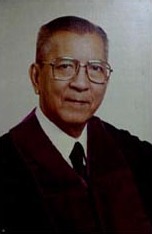Enrique Fernando facts for kids
Quick facts for kids
Enrique M. Fernando
|
|
|---|---|
 |
|
| 13th Chief Justice of the Philippines | |
| In office July 2, 1979 – July 24, 1985 |
|
| Appointed by | Ferdinand E. Marcos |
| Preceded by | Fred Ruiz Castro |
| Succeeded by | Felix Makasiar |
| 80th Associate Justice of the Supreme Court of the Philippines | |
| In office June 30, 1967 – July 1, 1979 |
|
| Appointed by | Ferdinand E. Marcos |
| Preceded by | José Maria Paredes |
| Succeeded by | Venicio Escolin |
| Personal details | |
| Born |
Enrique Medina Fernando
July 25, 1915 Malate, Manila, Philippine Islands |
| Died | October 13, 2004 (aged 89) Manila, Philippines |
| Spouse | Emma Quisumbing-Fernando |
Enrique Medina Fernando (born July 25, 1915 – died October 13, 2004) was an important legal figure in the Philippines. He became the 13th Chief Justice of the Supreme Court of the Philippines. He was known for his deep understanding of the country's laws and for being a law professor. He served on the Supreme Court for 18 years, including 6 years as its Chief Justice.
Contents
Early Life and Education
Enrique Fernando was born in Malate, Manila. He studied law at the University of the Philippines College of Law. He graduated with high honors in 1938. This means he was one of the best students in his class.
Soon after becoming a lawyer, he started teaching at his old university. He taught there full-time until 1953. Even after that, he continued to teach as a special lecturer for many years. He was even named the George A. Malcolm Professor of Constitutional Law. This is a special title for experts in laws about how the government works. He also taught at the Lyceum of the Philippines. Many of his students later became important judges or successful lawyers.
In 1947, he was accepted into Yale Law School in the United States. He was the first Filipino to be a Sterling Fellow there. He earned his Master of Law degree the next year.
Working for the Government
In 1953, Fernando was appointed as a Code Commissioner. He helped write and update the country's laws until 1964. In the 1950s, he also advised two Philippine Presidents, Ramon Magsaysay and Carlos P. Garcia.
Before joining the Supreme Court, he also worked as a lawyer for many people and companies. One of his law partners was Senator Lorenzo Tañada. Together, they wrote a popular textbook about constitutional law. Throughout his life, Fernando wrote several books about laws related to the government and how it operates.
Time on the Supreme Court
In 1966, President Ferdinand Marcos appointed Fernando as his legal adviser. The next year, Marcos appointed him to be an Associate Justice of the Supreme Court.
Fernando became the Chief Justice in 1979. This happened when Chief Justice Fred Ruiz Castro sadly passed away. Fernando was the most senior Associate Justice at that time. This meant he had served on the court the longest among the other Associate Justices. So, President Marcos promoted him to Chief Justice.
Important Legal Decisions
When he joined the Supreme Court, Fernando was already known as a top expert on constitutional law. He was also a strong supporter of people's freedoms. He was especially good at understanding American legal ideas about how a republic should work and about individual rights. He had many chances to explain these important ideas during his 17 years on the Court.
In a case called Morfe v. Mutuc (1968), Fernando wrote the Court's decision. This case was about a law that required public officials to report what they owned and owed. This law was meant to fight corruption. Fernando wrote that this law did not take away a person's right to liberty or privacy. However, this case was important because it was the first time the Philippine Supreme Court officially recognized that people have a constitutional right to privacy. This means the right to keep some personal information private is protected by the country's main law.
Fernando also strongly believed in the "clear and present danger" test. This test helps decide when the government can limit someone's freedom of speech. He explained this in his main opinion in Gonzales v. COMELEC (1969). He also wrote about it in his differing opinion in Badoy v. Ferrer (1970). He believed this test was the only fair way to limit free expression.
Later Years
Fernando's long service on the Court ended in 1985. This was when he reached the mandatory retirement age of 70. The next year, President Marcos was removed from power. Another important judge, Claudio Teehankee, became the new Chief Justice.
Fernando continued to work as a lawyer until shortly before he passed away in 2004. He was 89 years old. Even after retirement, the Supreme Court sometimes asked for his expert advice. This happened in a famous case called Manila Prince Hotel v. GSIS (1997).
Enrique Fernando is buried at the Libingan ng mga Bayani, which is the National Heroes' Cemetery.

